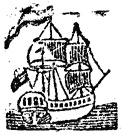Capt. William Coit Describes His Ship
 Capt. William Coit was a Connecticut lawyer with a supersized personality. He arrived at the siege of Boston as a militia captain, and in the fall of 1775 Gen. George Washington made him commander of an armed schooner renamed Harrison, sailing out of Plymouth. This was part of the fleet that I’ll discuss on 20 February at Longfellow National Historic Site in my talk “Cambridge: Birthplace of the American Navy?”
Capt. William Coit was a Connecticut lawyer with a supersized personality. He arrived at the siege of Boston as a militia captain, and in the fall of 1775 Gen. George Washington made him commander of an armed schooner renamed Harrison, sailing out of Plymouth. This was part of the fleet that I’ll discuss on 20 February at Longfellow National Historic Site in my talk “Cambridge: Birthplace of the American Navy?”
On 7 Nov 1775 Coit wrote to his friend Samuel Blachley Webb, then an aide-de-camp to Gen. Israel Putnam in the American camp:
Since I parted with you, I have made a blackguard snatch at two of their [i.e., the British military’s] provision vessels, and have them safe at Plymouth, and if you were where you could see me and did not laugh, all your risible faculties must perish.The Harrison was fast on the water, and maneuverable, and even managed to survive running aground several times. But Washington soon found Coit and his men hard to bear.
To see me strutting about on the quarter-deck of my schooner!—for she has a quarter-deck—ah, and more than that too—4 four pounders [cannon], brought into this country by the company of the Lords Say and Seal, to Saybrook when they first came [Saybrook was settled in 1635]. A pair of cohorns that Noah had in the Ark; one of which lacks a touch-hole, having hardened steel drove therein, that she might not be of service to Sir Edmund Andros [in 1689]—Six swivels, the first that ever were landed at Plymouth [in 1620], and never fired since.
Now, that is my plague; but I can tell you somewhat of my comfort. My schooner is used to the business, for she was launched in the spring of 1761, and has served two regular apprenticeships to sailing, and sails quick, being used to it.
Her accommodations are fine; five of us in the cabin, and when there, are obliged to stow spoon fashion. Besides, she has a chimney in it, and the smoke serves for bedding, victuals, drink and choking. She has one mast too, which is her foremast; she has a mainmast, but it was put in so long ago, that it has rotted off in the hounds. She has a deck, too. When it was first made, it was new; and because it was ashamed of being old, the first time we made use of a clawed handspike, it broke a hole through; notwithstanding the wench knew it was directly over the magazine.
Upon the whole, if there comes peace, I would recommend her and her apparatus, to be sent to the Royal Society; and I dare eat a red-hot gridiron if ever they have had, or will have, until the day of judgment, any curiosity half equal to her.
I haven’t time to give you her character in full, but, in short, she is the devil. But while I can keep the sea, and light only on unarmed vessels, she will do very well. But if obliged to fire both guns of a side at a time, it would split her open from gunwale to her keelson.
Here’s Coit’s house in New London, from Historic Buildings of Connecticut.

2 comments:
Judging by how negative Capt. Coit's view of his own ship was, it's astounding that she was as successful as all that, and managed to survive running aground more than once. I've heard sea shanties, like "The Ebenezer", describe ships in sarcastic and negative tones similar to this account, but it sounds like she wasn't all that bad. Was it common for sailors and captains to be so pessimistic about their own vessels?
My impression is that Coit was what we’d call “a character,” and never let an opportunity for a joke pass by. (I’ve wrestled with this problem myself.) I think Washington came to see Coit and his officers as less than serious, and in 1776 the captain departed for more opportunity in Connecticut.
In this letter to a friend, Coit was laying on the detail for literary effect. The touch-hole of one of his mortars had indeed been plugged, but accounts show it was also drilled out—a detail he omitted. His ship was old, with parts rotting, and was eventually ruled unfit for service. At the same time, he was able to use it to good effect.
Coit commanded one of the most daring actions by the Continental Army’s navy, an attempt to grab a British military ship within Boston harbor, and he seized more valid prizes better than some of the other captains. But his personal style seems to have been a liability getting in the way of his accomplishments.
Post a Comment